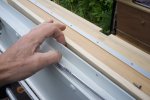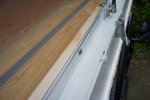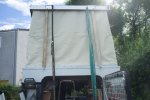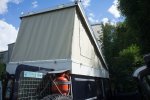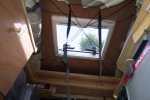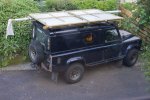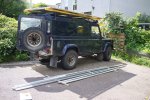Well the solar panel is now welded on with some kind of permanent rubberymasticy stuff that sticks even underwater (so it claims), and it was well weighted as it dried overnight so hopefully thats it on more securely than before.

This morning I wrestled an 8x4 foot sheet of thin flooring ply onto the side and made a template of the angles at rear for the fabric maker to work off - just to confirm his measured sizes. Was interesting to see the roof with 'form' and 'structure' as it really gives a sense of the shape and space inside.
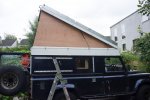
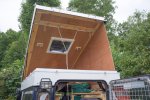
Next into town and within a short time it was cut and the lower edge pocket stitched leaving the top loose and unstitched so that I can temporarily fix the bottom edge on to the van and establish exactly the height required, allowing a little less so that the roof struts are pushing up against it to keep it under tension. It seemed more sensible (although more work) to do it this way, but probably more likely to get an exact fit. The last thing I want is bits of fabric flopping around looking shabby, and which will also crease and wear unevenly.

I'll have a go at fitting it over the weekend depending on the weather. When it's on I'll draw a few lines to allow the fellow doing the sewing to have exact dimensions to work to.

This morning I wrestled an 8x4 foot sheet of thin flooring ply onto the side and made a template of the angles at rear for the fabric maker to work off - just to confirm his measured sizes. Was interesting to see the roof with 'form' and 'structure' as it really gives a sense of the shape and space inside.


Next into town and within a short time it was cut and the lower edge pocket stitched leaving the top loose and unstitched so that I can temporarily fix the bottom edge on to the van and establish exactly the height required, allowing a little less so that the roof struts are pushing up against it to keep it under tension. It seemed more sensible (although more work) to do it this way, but probably more likely to get an exact fit. The last thing I want is bits of fabric flopping around looking shabby, and which will also crease and wear unevenly.

I'll have a go at fitting it over the weekend depending on the weather. When it's on I'll draw a few lines to allow the fellow doing the sewing to have exact dimensions to work to.




